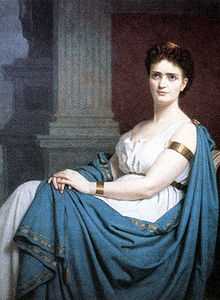Signe Hebbe

Signe Amanda Georgina Hebbe (30 July 1837 – 1925), was a Swedish singer (soprano), actress, and theatre pedagogue.
Signe Hebbe was born in Värnamo to the journalist Vendela Hebbe. In 1848, at the age of eleven, she studied music at the Lindblad pianoschool, at the school of the Royal Swedish Opera and for Karolina Bock. From 1852–1854, she studied at the conservatory in Berlin. She debuted in a dramatic part in the Royal Dramatic Theatre in 1855, but did not succeed in spoken drama and continued to study singing.
She was accepted at the Paris conservatory in 1856, where she became the first singer from Scandinavia to receive a medal. She instructed in plastic at the conservatory and was the teacher of Sarah Bernhardt when she was the replacement of Élie during his absence in 1860. Francesco Lamperti developed her singing in Milan and studied Adelaide Ristori and Ernesto Rossi for her dramatic talent.
She sang in Lyon from1861 and 1862, debuted in Frankfurt and was employed at the court theatre of Mannheim, Nationaltheater Mannheim. Between 1864 and 1879, she toured Europe and sang in Stockholm, Karlsruhe, Köpenhamn, Théâtre Lyrique in Paris, Warszawa, Geneva, Milano, Palermo, Helsingfors, and Oslo. As an actor, she was criticized for her way of acting, as she did not like to interpret the female parts as weak, but wanted to give them a more independent interpretation than the Victorian age wanted to view women.
In 1871, her contract at the Royal Swedish Opera stipulated that she should teach, and she was from this point very active as an instructor until her death in 1925. She opened her own school in 1877, and was from 1883 active at Dramatens elevskola and the Opera school, from 1886–1888 in the Royal Swedish Academy of Music, and in the years around 1900 on the Royal Dramatic Theatre. She preferred her own school, which paid better, and where she taught technique in speech, singing, plasticue and role analysis. She had been instructed in deep breathing by Delsartes and took this technique with her to Sweden. She had students from all Scandinavia, Europe and the USA. Two of her notable pupils were John Forsell and Carolina Östberg.
Notes and references
Bibliography
- Österberg, Carin et al., Svenska kvinnor: föregångare, nyskapare (Swedish women: Predecessors, pioneers). Lund: Signum 1990. (ISBN 91-87896-03-6)(Swedish)
- George Nordensvan: Svensk teater och svenska skådespelare från Gustav III till våra dagar. Andra boken 1842-1908 (Swedish theatre and Swedish actors from Gustav III to our days. Second book 1842-1908) (Swedish)
|